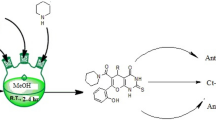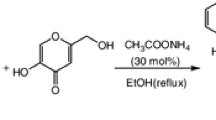Abstract
A new series of 3,3ʹ-disubstituted chiral (S)-BINOL derivatives 6a–6k has been synthesized via the Kumada and Suzuki–Miyaura coupling reactions using (S)-BINOL as the initial compound. The Kumada coupling has been found to be superior in terms of yields and reaction time. All the synthesized compounds have been screened for their antibacterial activity against Gram-positive and Gram-negative organisms using Penicillin and Streptomycin as standards. The most potent antibacterial activity has been determined for compounds 6a,6b, 6c, and 6d with MIC values ranging from 1.17 to 4.68 μg/mL against all bacterial strains tested. Molecular docking studies has presented an insight into the binding pattern of the top active ligands with the respective target protein.



Similar content being viewed by others
REFERENCES
Ankireddy, A.R., Syed, R., Gundla, R., Manasa, K.L., Reddy, C.V.R., Yatam, S., and Paidikondala, K., Russ. J. Gen. Chem., 2019, vol. 89, p. 2544. https://doi.org/10.1134/S107036321912034X
Ashok Reddy, A., Kalyani, P., Rambabu, G., Tuniki, B., Ramakanth, P., and Venkanna, B., Chemistry Select., 2019, vol. 4, p. 5563. https://doi.org/10.1002/slct.201803937
Orazio, G.D., Martorana, A.M., Filippi, G., Polissi, A., Gioia, L.D., and Ferla, B.L., Chemistry Select., 2016, vol. 1, p. 2444. https://doi.org/10.1002/slct.201600516
Santosh, R., Selvam, M.K., Kanekar, S.U., Nagaraja, G.K., and Kumar, M., Chemistry Select., 2018, vol. 3, p. 3892. https://doi.org/10.1002/slct.201800222
Govindaiah, S., Sreenivasa, S., Ramakrishna, R.A., Chakrapani Rao, T.M., and Nagabhushana, H., Chemistry Select., 2018, vol. 3, p. 8111. https://doi.org/10.1002/slct.201801364
Laurel, L.S., and Don Tilley, T., J. Am. Chem. Soc., 2001, vol. 123, p. 2683. https://doi.org/10.1021/ja015509o
Shibasaki, M., and Yoshikawa, N., Chem. Rev., 2002, vol. 102, p. 2187. https://doi.org/10.1021/cr010297z
Evans, C.G., and Gestwicki, J.E., Org. Let., 2009, vol. 11, p. 14. https://doi.org/10.1021/ol901114f
Rajakumar, P., Selvam, S., Shanmugaiah, V., and Mathivanan, N., Bioorg. Med. Chem. Lett., 2007, vol. 17, p. 5270. https://doi.org/10.1016/j.bmcl.2006.12.071
Rajakumar, P., Raja, R., Selvam, S., Rengasamy, R., and Nagaraj, S., Bioorg. Med. Chem. Lett., 2009, vol. 19, p. 3466. https://doi.org/10.1016/j.bmcl.2009.05.019
Thirunarayanan, A., Raja, S., Mohanraj, G., and Rajakumar, P., RSC Adv., 2014, vol. 4, p. 41778. https://doi.org/10.1039/c4ra04967e
Vidal, M., Elie, C.R., Campbell, S., Claingand, A., and Schmitzer, A.R., Med. Chem. Commun., 2014, vol. 5, p. 436. https://doi.org/10.1039/C3MD00293D
Ashok, D., Shravani, D., Sarasija, M., and Sudershan, K., Russ. J. Gen. Chem., 2015, vol. 85(5), p. 1152. https://doi.org/10.1134/S1070363215050254
Wipf, P., and Jung, J.K., J. Org. Chem., 2000, vol. 65, p. 6319. https://doi.org/10.1021/jo000684t
Huang, J., and Nolan, S.P., J. Am. Chem. Soc., 1999, vol. 121, p. 9889. https://doi.org/10.1021/ja991703n
Perez Garcia, P.M., Di Franco, T., Orsino, A., Ren, P., and Xile, H., Org. Lett., 2012, vol.14, p. 16. https://doi.org/10.1021/ol302067b
Patel, N.D., Rivalti, D., Buono, F.G., Chatterjee, A., Qu, B., Braith, S., Desrosiers, J.N., Rodriguez, S., Sieber, J.D., Haddad, N., Fandrick, K.R., Lee, H., Yee, N.K., Busacca, C.A., and Senanayake, C.H., Asian J. Org. Chem., 2017, vol. 6, p. 1285. https://doi.org/10.1002/ajoc.201700137
Jin, L.M., Yanniani, L., Ma, J., and Quan, L., Org. Lett., 2010, vol.12, p. 15. https://doi.org/10.1021/ol1014152
Seva, L., Hwang, W.S., and Sabiah, S., J. Mol. Catal. A: Chem., 2013, vol. 418, p. 125. https://doi.org/10.1016/j.molcata.2016.03.032
Zhang, Z.G., Dong, Z.B., and Shan Li, J., Chirality, 2010, vol. 22, p. 820. https://doi.org/10.1002/chir.20842
Ankireddy, A., Gundla, R., Balaraju, T., Banothu, V., Gundla, K.P., Addepally, U., and Chimakurthy, J., Eur. J. Chem., 2018, vol. 9(4), p. 322. https://doi.org/10.5155/eurjchem.9.4.322-330.1748
Mali, P.R., Chirke, S.S., and Meshram, H.M., Chemistry Select., 2017, vol. 2, p. 10718. https://doi.org/10.1002/slct.201702135
Hatano, M., Horibe, T., and Ishihara, K., J. Am. Chem. Soc., 2010, vol. 132, p. 56. https://doi.org/10.1021/ja909874b
Kabir, M.S., Monte, A., and Cook, J.M., Tetrahedron Lett., 2007, vol. 48, p. 7269. https://doi.org/10.1016/j.tetlet.2007.08.047
Lee, C.Y. and Cheon, C.H., J. Org. Chem., 2013, vol. 78(14), p. 7086. https://doi.org/10.1021/jo400928q
Battula, K., Narsimha, S., Reddy Nagavelli, V., and Srinivasa Rao, M., J. Serb. Chem. Soc., 2016, vol. 81, p. 1. https://doi.org/10.2298/JSC151222088B
Funding
We acknowledge Department of Science and Technology (DST) (DST-SERB-ECR/2016/000288) India for providing the financial assistance and Gandhi Institute of Technology (GITAM) University for providing the facility. We would like to thank Prof.G.A.Rama Rao, Principal SoS, (GITAM), for his voluble suggestions while preparing the manuscript. The author RS thank CSIR-HRDG for the award of CSIR-SRAship [13(8906-A)/2017-pool].
Author information
Authors and Affiliations
Corresponding author
Ethics declarations
No conflict of interest was declared by the authors.
Rights and permissions
About this article
Cite this article
Ankireddy, A.R., Paidikondala, K., Syed, R. et al. Synthesis of Chiral 3,3ʹ-Disubstituted (S)-BINOL Derivatives via the Kumada and Suzuki Coupling and Their Antibacterial Activity. Russ J Gen Chem 90, 1507–1517 (2020). https://doi.org/10.1134/S1070363220080198
Received:
Revised:
Accepted:
Published:
Issue Date:
DOI: https://doi.org/10.1134/S1070363220080198




